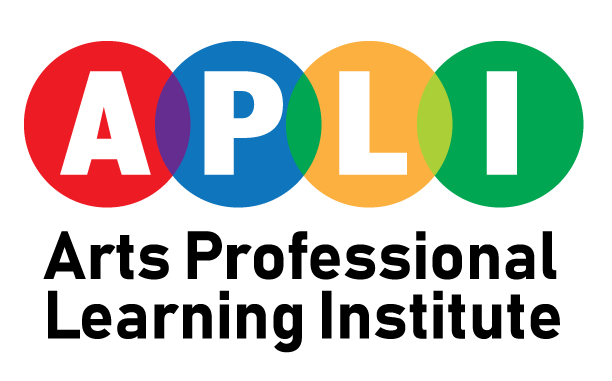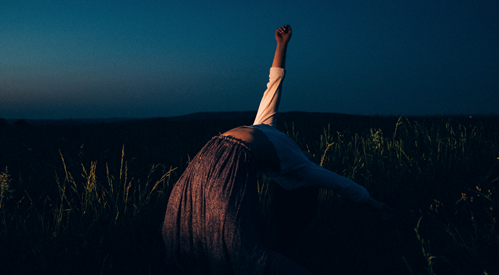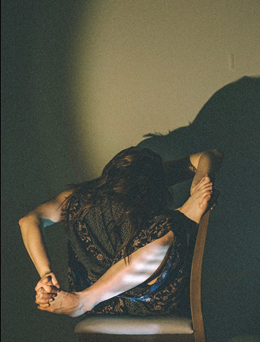Deaf History in the Making: Deaf Art & Dance with Anna Gichan
Image Description: Anna Gichan is pictured between a mirror and sheer white fabric. She is a white woman with dark brown hair. Her left hand is lifted and is touching the mirror. She is smiling and her eyes are closed.
APLI Fellow Anna Gichan is a deaf/hoh artist who graduated from Rutgers University Mason Gross School of the Arts in 2017 with a BFA in dance. She studied abroad for a year in Israel learning Gaga at the Jerusalem Academy of Music and Dance, where upon graduating, she worked with Rioult Dance as a teaching artist, practicing and teaching their style derived from Graham. Anna grew up as a competitive gymnast, avid rock climber, and contemporary dancer. Her style is inspired by her other movement-based activities (i.e. climbing, gymnastics, motorcycles, anything she can get her hands on, even skateboarding) and combines those diverse movement styles with her dance training, most notably in contact improvisation and floorwork.
Image Description: Anna is performing a backbend in a field with tall grass. The sky looks dark and moody. She is wearing a long skirt which is dark in pattern and a white, long sleeved top. Her arms are extended into the sky and over head.
WHILDEN: Anna, What is your d/Deaf story?
I identify as small d deaf, Hard of Hearing, moderate severe to profound. My deafness is invisible. It is not centered within the people and the spaces I socialize with. It is not centered in the institutions I learn with, nor in the careers I pursue, and it is not in my family. Oralism is the main mode of communication, and my primary language is assimilation into hearing culture. I read lips, eyes, eyebrows, your body moving in space. I read mirrors, reflections, and lights. I have a BTE (behind-the-ear hearing device) on/off switch to think about when I sleep, shower, sweat. It's Bluetooth and plays music, as well as rings your calls (please text or Facetime).
Lowercase d deaf means I blend in, mold myself to the people and the space. Capital D Deaf means deafness is a visible part of the people and the spaces. ASL is the primary language. Deaf culture is the predominant culture. There’s a history to follow, mirrors to inform, lights to alert, people to sensorly relate with. It means community and regular active engagement with the culture.
Image Description: Anna is submerged to her waist in a body of water, possibly a river or lake. She is wearing a grey t-shirt, which is wet from the water. She is leaning to the right, her face uplifted to the sky, her arms floating in the air above her head.
When I was about 3 years old my parents learned I was deaf. My grandma noticed I didn’t respond to my name or sounds coming from behind me and told my mother, “You know Anna might be deaf.” My mom sat me on a counter and tested it out for herself. Grandma was right. I wasn't responding to my name, claps, or sounds, especially those coming from behind me. Mom quickly set up an appointment. Lo and behold, a professional confirmed what my grandmother suspected; I don’t hear like most people... Aka deaf. The story goes, my mom cried for one day and that was all of the crying she did, then she set up multiple doctors appointments, and I got fitted for my first pair of ears as my mom and dad discussed my education. They enrolled me in Summit Speech School, a school which advocates for the use of oralism.
From elementary school to my first year in high school, I had an itinerant teacher from Summit Speech School who checked that the teachers were properly giving accommodations in class and that I was learning at a rate that matched everyone else. I reluctantly wore an FM system and went to speech therapy from kindergarten to high school. Speech therapy included S’s Sh’s Z’s Th’s F’s. By high school I was tired of ‘correcting’ my speech.
WHILDEN: Did you learn ASL in school?
No, not until I was an adult. My relationship with ASL came out of desperation for when I am exhausted by wearing hearing aids and/or lipreading. I am nowhere near fluent. I started taking some ASL classes at the Marie H Katzenbach School for the Deaf in NJ and watching Bill Vicars on YouTube. When the pandemic struck and my new ears came in, I started taking private ASL lessons with Garret Zuercher and now use it mostly to assist English when my ears are out with friends who I’m comfortable being ears out with. I teach them the words I need them to know so that there is some ease in communication. I wish ASL was taught in my schools. I could have used it, and my peers, my community, could have learned it with me. If there’s a deaf child at a school, ASL should be brought into the classroom in some way.
WHILDEN: How would you describe your art? Specifically your piece “On The Tip Of My Tongue-Breathe”
Image Description: On the Tip of my Tongue-Breathe is pictured here. Images of lips forming the word “breathe” are pictured, with images from TIME collaged within the drawing.
My art is still taking shape. I’m trained as a dancer, drawn to improvisation, athleticism, contact improvisation with handstands, inversions, backbends being my guilty pleasures. As of late, I've been diving into photography and lip drawings which seems to be resonating with people. The drawings and photography reflect how I experience conversations and spaces. It's answering the question “How do I hear?” As a deaf/hoh individual in a hearing world, lipreading, mirroring movements, observing lights and shadows is a must. Deaf sound artist Christine Sun Kim infuses the movement of sign language into her work, which I think is pretty awesome artistically and politically. I became curious about how I too could infuse my language and some movements of deaf/hoh language comprehension tools like lipreading, watching, mirroring into my work.
For “On The Tip Of My Tongue-Breathe',' I was drawing it for an exhibit: “Occupation: Artists in 2020” curated by Morgaine DeLeonardis at SMUSH gallery in Jersey City, November 2020. I drew the words I was frequently hearing/lip reading at that time which included breathe. My occupation is a dancer, breathe is a word I’ve been told by many dance teachers I needed to do (I struggled). Then, with the pandemic, civil rights movement, and the lack of support for artists (freelancers-ouch!) the word took on a deeper meaning in our social consciousness. Frequently being spoken, written, printed, thought about, and lingering in the space between our masks and zooms calls… Breathe was on the tip of everyone’s tongue. So I cut out images and words from TIME magazine that reflect my personal relationship with the word breathe as a dancer into a reflection of what I saw was society's relationship with the word. For me it’s mostly shrouded by anxiety or a search for calm.
WHILDEN: Anna, what are your dreams for the future in regards to your love of art and dance?
Phew, what a question! Dance is my life. Movement is my life. Art and dance and movement. My dream is to pursue my education at Gallaudet University to add more depth to my artistry and to increase little d deaf visibility within the arts and education. I dream of traveling the world. I dream of combining cinematography with dance. I dream of dancing in stunning spaces and sharing those spaces with others. Art gives those without a voice, a voice, and I intend to use my body and my art to communicate how I see the world. Hopefully someone out there won’t feel as alone as I did growing up and my work can pave a path of visibility for those like me who often do not see themselves represented in their communities.
For now my immediate dreams are to bring floorwork and partnering work into museum spaces culminating in videos alongside increasing my knowledge of deaf history. And… hopefully getting better at cooking.
Image Description: Anna is sitting in a chair in front of a blank wall. Light and shadow play over the wall in front of her. Her body is bent and contorted, her arms and legs intertwined and twisted behind and before her.
About Anna Gichan: Anna has performed at the ADA Lead On 30th Anniversary event (2020), The Cooper Hewitt Museum as part of their Bodystorming Access Interaction Lab Workshop (2019), Loews Jersey Theater with Morgaine DeLeonardis (2019), Roulette with Josiah Cuneo (2019), Old First Reformed Church with Micayla Wynn (2019), Dixon Place and Yi Gallery with Ayalis in Motion (2018), Judson Memorial Church with Arts for Art (2018) , Newburgh Illuminated Dance Festival, and Triskelion Arts with Mignolo Dance (2018). Her work has been presented at SMUSH Gallery Occupation: Artist (2020) Gibney Dance Center Elevator Opening Ceremony (2020), The Tank (2019), Flux Factory's "Talk Back" (2020), and supported by the Brooklyn Arts Exchange Disabled Artist Space Grant (2019 +2020). Anna is a teaching artist through Artists in Education (AIE). She has had the opportunity to teach her artistic practice at Eyebeams Digital Day Camp (2019), RIOULT Summer Camp (2019), Flux Factory (2019), a 20 day residency at PG Chambers (2020 & 2021), ROTATIONS with Yo-Yo Lin and Pelenakeke Brown (2020). She was introduced to Disability Artistry and Justice through DANT (Disability Arts NYC Task Force, 2019).
Currently, Anna is dancing with Olga Rabetskaya and co-choreographed a film #freebelarus which has been presented at Rollout Dance film festival, IMARP Mostra Internacional de danca, Dance@30FPS, Festival DANZENICA, Quinzena de Danca de Almada. Anna is also in the midst of choreographing a three part dance series about depression with Amy Buchwald which will premiere in the summer of 2021. Anna is currently a teaching artist with Artists in Education, a co-sponsored project of the New Jersey State Council on the Arts and Young Audiences Arts for Learning NJ & Eastern PA.
View Anna’s Work
Words To Someone Else - Matt Bastos https://vimeo.com/328289774
Image Description: Image contains the face of Kristy Whilden, a white woman with light blue eyes, and wavy, auburn hair that runs past her shoulders. Kristy is smiling in the photo.
About the Author: Kristy Whilden (she/her small d deaf late deafened adult) is a former music teacher with a BA from Rutgers University that owned a music school for over 10 years. Five of her students even won the right to play piano at the great Carnegie Hall in New York City! In 2014 Miss Whilden was diagnosed with hereditary Progressive Sensorineural Hearing loss. The thought of not being able to hear the music that once shaped her life was devastating. She went back to school and obtained a degree in Deaf Studies and American Sign Language from Rowan College at Burlington County. At this point her focus turned from music to musical theatre. She wanted all d/Deaf eyes on the stage and not always having to rely on the interpreter on the floor. Hands Up Silent Theatre non-profit was born. At Hands Up she encourages d/Deaf students to learn more about the performing arts and encourages hearing children to learn ASL and interact with d/Deaf peers. Together they create performances for the d/Deaf and hearing to enjoy as one. Miss Whilden is now back in school getting her Master’s in Deaf Education at St. Joseph’s University and will soon finish her Master in Business from Western Governors University. Although her life is Deaf Theatre, her real love is Deaf History. As an aspiring author and playwright, Miss Whilden is hoping to spread awareness and importance d/Deaf Culture and History. It is also her goal to encourage everyone to learn ASL to help bridge communication gaps between the d/Deaf and hearing communities and to promote inclusion and access in every aspect of life.







